 About
Montana Agate
About
Montana Agate
|
|
|
----------- ----------- ----------- ----------- ----------- -----------
|
skip to Physical properties of Montana agate skip to Formation of Montana agate skip to Finding Montana Agate skip to Grades of Montana Agate
Agate is a moderately hard rock, primarily composed of silica (quartz). Montana agate and sapphire are the two State gemstones of the State of Montana. Montana agate is sometimes also referred to as “moss agate” (agate that has colored inclusions that may resemble moss) or “scenic agate”. Physical Properties (back to top of page) The individual crystals of agate are microscopic (cryptocrystalline), which helps to give agate a hardness of approximately 7 on the Mohs hardness scale. The hardness is important for jewelry-making because relatively hard rock can take a good polish and is durable (more about the structure of agate and quartz). The background (matrix) of Montana agate ranges from nearly clear, through milky grey-blue to white. If the agate is composed of very fine layers, a small percentage of Montana agates may show rainbow iridescence (also known as iris agate). Formation of Montana Agate (top of page) In general, agates form when silica in groundwater is deposited in openings in the subsurface. It is generally believed that Montana agates were formed as the result of volcanic activity in the Yellowstone Park area millions of years ago, which deposited a tremendous amount of silica-rich ash over a wide area. Some Montana agates, such as “limb casts”, appear to have originated from wood that became buried by ash and fossilized after the volcanic activity. (more about Montana's geologic history and the genesis of Montana agate) Credit: Dr. Roger Pabian of Nebraska State University maintains an awesome bibliography of agate literature at his website: http://csd.unl.edu/agates/agatepageintro.asp, which was invaluable in researching some information on Montana agate for this page and for related pages. It's probably safe to say that all Montana agate has been transported many miles from its original location. The transport process has tumbled the agates along the streambed, and weak or cracked rocks have either fallen apart or else the cracks have been “healed” by exposure to the silica-rich waters of the Yellowstone River. One of the most attractive features of Montana agate is the colored inclusions, which are made up of minerals (such as iron and manganese). These inclusions form when mineral-laden water is “wicked” into the rock through cracks or fractures and the mineral content of the water is deposited within the rock. (more about internal structure of Montana agate) The highest-quality Montana agate is free from cracks or “checks”. Some of the most beautiful Montana agates contain dendrites, or tree-like plumes of mineral inclusions. (more about inclusions in Montana agate) Finding Montana Agate (top of page) Montana agates are found over a broad area along the Yellowstone River valley and adjacent plateau areas from Emigrant MT to the North Dakota border. Rough Montana agate often resembles a potato, and is difficult to distinguish from other rocks. In the plateau areas, Montana agates may have developed a distinctive white crust, although the agates that are found away from the Yellowstone River are often more cracked and checked than the rocks that are found along the river. Most people start collecting Montana agate by breaking likely-looking rocks with a hammer in order to learn to identify Montana agate….. experienced collectors try to avoid hammering the rocks in order to avoid ruining a potentially beautiful specimen. Grades of Montana Agate (top of page) Back at home, the best way to evaluate Montana agate is under a strong light. Wetting the specimens may also help to show off the interior. (more about working with Montana agate). The finest Montana agate has a clear matrix with well-defined orange-red and black inclusions that form bands, specks, trees, or other shapes. Unchecked rock is more desirable for jewelry-making than rock that is checked or fractured. Tom Harmon of Crane, MT (link to Harmon's website) has published an excellent book that classifies Montana agate according to some descriptive categories (click any image to see a better picture): |
||||
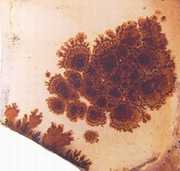 Layered Dendrites |
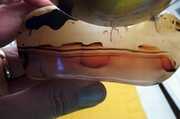 Ribbon Banded Nodules |
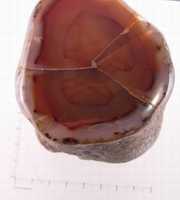 Ribbon Banded Limb Casts |
|||
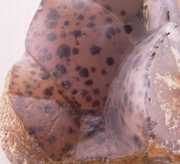 Thin Line Dendrite Casts and Nodules |
 Thin Line Floating Dendrites |
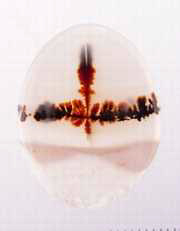 Fracture Line Dendrites
|
|||
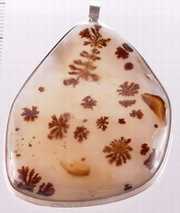 Thin Line Crust Dendrites |
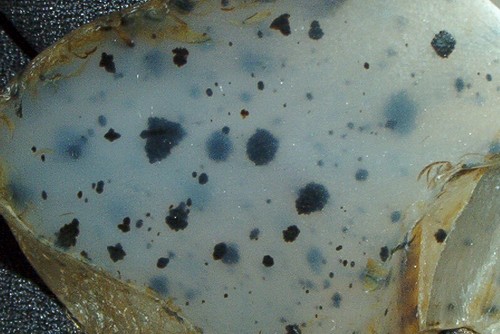 Full Bodied Dendrites |
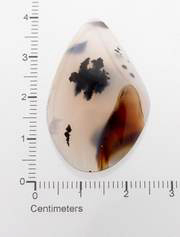 Combination Dendrites and Banded Agate |
|||
|
|
|||||